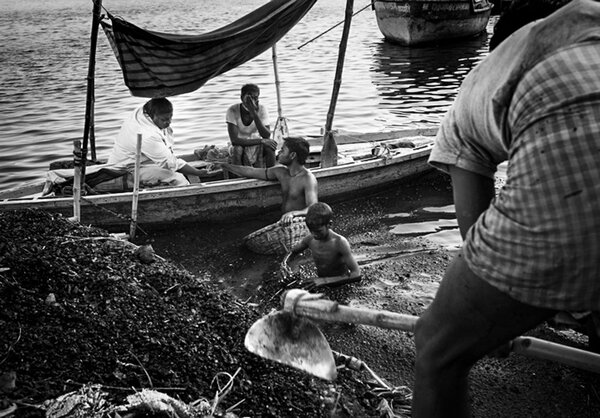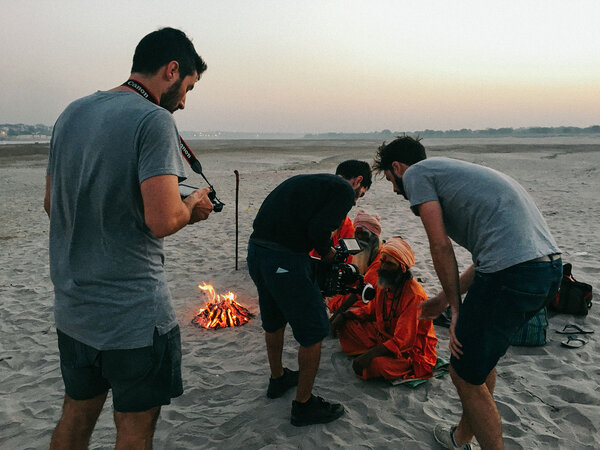India Song
Cinematographer Romain Alary discusses his work on the music video for San Zhi’s song "Give it Up"How did this black-and-white music video come about ?
Romain Alary : The origin of this project lies in my trip to India over ten years ago along with my cousin Antoine Lévi. I remember a black-and-white photograph that had made a strong impression on me at that time, depicting a man entirely dressed in white aboard a boat watching a child in the middle of the Ganges collecting the remains from cremations… We later had the idea of creating a film on the procession to the riverbank. A black and white film, taking its inspiration from the photojournalists of the 1980s. We chose to self-finance this project, and so three of us left for India, including my assistant operator Etienne Burguy, for a ten-day trip on location in Varanasi.

So, you mean to say that neither the record label nor the singer initiated the shoot ?
RA : Precisely. The video was made in reverse. That’s rather rare ! We really started with a shoot made by a group of friends, which could also have been transformed into a simple short film, and we ended up offering it to record labels, one of which convinced us to transform it into a music video. What really motivated us is that we shot the film with total artistic freedom. It might be considered that the resulting film is strictly identical to our initial intention, without any concessions or restrictions. We are very proud of being selected at Camerimage !
How did you approach this ? Was editing completed before you even knew the music ?
RA : About a minute of the film was edited with traditional Japanese music (Taiko) as a provisional soundtrack. Guillaume, one of the members of the group The Shoes, made his decision on the basis of that element and proposed the song by San Zhi, a group he worked with. We both thought that the association between the images and the sound worked well. Conforming, FX, and colour timing were done by Scott Harris in Amsterdam at GlassWorks, all with the full trust of the musician and the label.

Let’s return to the shoot. What were the main issues you faced ?
RA : One of the keys of the success of our ten days of shooting in India was how small our crew was (just three people) and the quality of our fixer, Raju Verma. Thanks to him, a lot of doors opened to us, and in particular being allowed to shoot at the Main Ghat in Varanasi (the sacred spot on the riverbank where cadavers are cremated), which is extremely rare for any film crew. A funny story : the manager of that place, who opened his doors to us, turned out to be one of the brothers of the man dressed in white on the 1970s photo that had inspired us !
As I mentioned, we had decided on black and white from the get-go. I shot with a RED Epic with a LUT in B&W, without ever paying attention to the colour except in terms of rendering between greys, blacks, and whites. Because of the extreme mix of colours one sometimes encounters in India in both public and private lighting, where sodium mixes with mercury or unexpected LEDs, black-and-white really helped us to unify the various shots and to give a strong tonality to the film, which was entirely shot in natural light.
What is funny is that when the postproduction company received the elements for conformation, they didn’t receive the notice that the film was going to be in black and white. So, on the first day of colour timing, Antoine and I showed up and they showed us the conformed film in colour !
The music video is more of a greyscale gradient than truly black-and-white…
RA : We did a lot of work with the colourist to reduce the whites and to end up with a sort of gradient between very deep black, grey, and dark white. That went along with the shooting on location which we tried to control as much as possible by only shooting at the beginning and the end of each day. Our choice of Scope Lomo anamorphic lenses, plus the RED Epic, plus black-and-white, was the right combination for this film.
But there is that shot of the burning skull in the water that stands out from the rest…
RA : That’s the only image that wasn’t shot on location, instead our little crew shot it in studio conditions in Paris. The integration between the skull, the fire and the water was handled afterwards by GlassWorks. It is a shot that does stand out from the rest a bit because of its fictional nature, but it was necessary to reinforce the film’s narration.
Happy ?
RA : The experience of this shoot was so intense, both from a human and an artistic perspective, for us, that we have decided to do it again this year in Tokyo, with the same configuration and team, but this time with a Bolex SBM S16 and 25 Kodak reels. Other projects will follow, that’s for sure.
(Interview by François Reumont on behalf of the AFC, and translated from French by A. Baron-Raiffe)
“Give it Up” by San Zhi
Produced by Antoine & Romain
Directed by Antoine Lévy
Fixer : Raju Verma
Assistant : Golu
Editing : Everest Studio, Paris
Editor : Manuel Coutant
Production Coordinator : Salt Ibraeva
Storyboarder : Younès Jabrane
Intern : Arturo Perez Orts
Titles and Graphics : Anna Kiosse, Rich Andrews
Music : written, performed, recorded and produced by Suraya, Dennis, Charlie Trimbur, and The Shoes (with a bit of help from Hervé)
Mastered by Fréderic Labone @GUM
In the portfolio below, you will find a few stills and photos from shooting.
 En
En Fr
Fr




